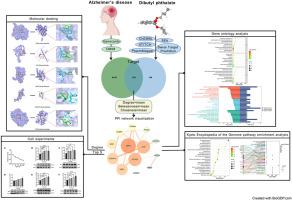Elucidating the mechanism of dibutyl phthalate on Alzheimer's disease through network toxicology, molecular docking and validation in mouse neuroblastoma cells
IF 3.5
3区 医学
Q2 FOOD SCIENCE & TECHNOLOGY
引用次数: 0
Abstract
Dibutyl phthalate (DBP), a widely used plasticizer, has been suggested to be neurotoxic. We aim to explore possible molecular mechanisms of DBP on Alzheimer's disease (AD) using a combined approach of network toxicology, molecular docking and experimental validations. We retrieved targets of DBP from ChEMBL and STITCH databases, while obtaining AD-related targets from GeneCards and OMIM databases. We identified 193 overlapping targets, and highlighted 13 core targets by protein–protein interaction analysis. Gene ontology and Kyoto Encyclopedia of Genes and Genomes analyses revealed that these targets are mainly enriched in neuroinflammation, synaptic signaling, and metabolic pathways. Molecular docking showed strong binding affinities for AD-related proteins, including translocator protein (TSPO), transcription factor c-Jun (JUN), estrogen receptor 1 (ESR1), cyclin-dependent kinase inhibitor 1A (CDKN1A), and prostaglandin-endoperoxide synthase 2 (PTGS2). In validation, we exposed DBP (0–200 μM) to N2a mouse neuroblastoma cells for 48 h. Western-blot demonstrated significant upregulation of TSPO, JUN, CDKN1A, and PTGS2, while ESR1 showed an upward trend without statistical significance. In conclusion, DBP may contribute to AD development by affecting AD targets expression (TSPO, JUN, CDKN1A, and PTGS2) and modulating pathways associated with neuroinflammation and synaptic function, providing mechanistic insights on how environmental toxicants may influence neurodegenerative processes.

通过网络毒理学、分子对接和小鼠神经母细胞瘤细胞验证阐明邻苯二甲酸二丁酯治疗阿尔茨海默病的机制
邻苯二甲酸二丁酯(DBP)是一种广泛使用的增塑剂,被认为具有神经毒性。我们旨在通过网络毒理学、分子对接和实验验证相结合的方法,探讨DBP治疗阿尔茨海默病(AD)的可能分子机制。我们从ChEMBL和STITCH数据库中检索DBP靶点,从GeneCards和OMIM数据库中检索ad相关靶点。通过蛋白相互作用分析,我们发现了193个重叠靶点,并突出了13个核心靶点。基因本体和京都基因与基因组百科分析显示,这些靶点主要富集于神经炎症、突触信号和代谢途径。分子对接显示ad相关蛋白具有很强的结合亲和力,包括转运蛋白(TSPO)、转录因子c-Jun (JUN)、雌激素受体1 (ESR1)、周期蛋白依赖性激酶抑制剂1A (CDKN1A)和前列腺素内过氧化物合酶2 (PTGS2)。为了验证,我们将DBP (0-200 μM)暴露于N2a小鼠神经母细胞瘤细胞48小时。Western-blot显示TSPO、JUN、CDKN1A和PTGS2显著上调,而ESR1呈上升趋势,但无统计学意义。总之,DBP可能通过影响AD靶点表达(TSPO, JUN, CDKN1A和PTGS2)以及调节与神经炎症和突触功能相关的通路来促进AD的发展,为环境毒物如何影响神经退行性过程提供了机制见解。
本文章由计算机程序翻译,如有差异,请以英文原文为准。
求助全文
约1分钟内获得全文
求助全文
来源期刊

Food and Chemical Toxicology
工程技术-毒理学
CiteScore
10.90
自引率
4.70%
发文量
651
审稿时长
31 days
期刊介绍:
Food and Chemical Toxicology (FCT), an internationally renowned journal, that publishes original research articles and reviews on toxic effects, in animals and humans, of natural or synthetic chemicals occurring in the human environment with particular emphasis on food, drugs, and chemicals, including agricultural and industrial safety, and consumer product safety. Areas such as safety evaluation of novel foods and ingredients, biotechnologically-derived products, and nanomaterials are included in the scope of the journal. FCT also encourages submission of papers on inter-relationships between nutrition and toxicology and on in vitro techniques, particularly those fostering the 3 Rs.
The principal aim of the journal is to publish high impact, scholarly work and to serve as a multidisciplinary forum for research in toxicology. Papers submitted will be judged on the basis of scientific originality and contribution to the field, quality and subject matter. Studies should address at least one of the following:
-Adverse physiological/biochemical, or pathological changes induced by specific defined substances
-New techniques for assessing potential toxicity, including molecular biology
-Mechanisms underlying toxic phenomena
-Toxicological examinations of specific chemicals or consumer products, both those showing adverse effects and those demonstrating safety, that meet current standards of scientific acceptability.
Authors must clearly and briefly identify what novel toxic effect (s) or toxic mechanism (s) of the chemical are being reported and what their significance is in the abstract. Furthermore, sufficient doses should be included in order to provide information on NOAEL/LOAEL values.
 求助内容:
求助内容: 应助结果提醒方式:
应助结果提醒方式:


